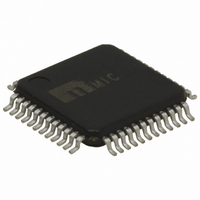MIC2593-2BTQ TR Micrel Inc, MIC2593-2BTQ TR Datasheet - Page 23

MIC2593-2BTQ TR
Manufacturer Part Number
MIC2593-2BTQ TR
Description
IC PCI HOT PLUG CTLR DUAL 48TQFP
Manufacturer
Micrel Inc
Type
Hot-Swap Controllerr
Datasheet
1.MIC2593-2YTQ.pdf
(26 pages)
Specifications of MIC2593-2BTQ TR
Applications
PCI, PCI-X
Internal Switch(s)
No
Voltage - Supply
3.3V, 5V, ±12V
Operating Temperature
0°C ~ 70°C
Mounting Type
Surface Mount
Package / Case
48-TQFP
Lead Free Status / RoHS Status
Contains lead / RoHS non-compliant
Other names
MIC2593-2BTQTR
MIC2593-2BTQTR
MIC2593-2BTQTR
50ms, I
50Mv nominal, and the fast-trip threshold is 100mV. If the
output is connected to a 0.60Ω load, the output current
from the MOSFET for the slot in question will be regulated
to 5.0A for 50ms before the MIC2593 circuit breaker trips.
During that time, the dissipation in the MOSFET is given
by:
At first glance, it would appear that a really hefty MOSFET
is required to withstand this sort of fault condition. This is
where the transient thermal impedance curves become
very useful. Figure 13 shows the curve for the Vishay
(Siliconix) Si4430DY, a commonly used SO-8 power
MOSFET.
Taking the simplest case first, we’ll assume that once a
fault event such as the one in question occurs, it will be a
long time, several seconds, before the fault is isolated and
the channel is reset. In such a case, we can approximate
this as a “single pulse” event, that is to say, there’s no
significant duty cycle. Then, reading up from the X-axis at
the point where “Square Wave Pulse Duration” is equal to
0.1sec (=100msec), we see that the Z
to a highly infrequent event of this duration is only 7% of
its continuous R
This particular part is specified as having an R
35°C/W for intervals of 10 seconds or less. Thus:
Assume T
the drain leads, no airflow.
Recalling from our previous approximation hint, the part
has an R
Assume it has been carrying just about 5A for some time.
When performing this calculation, be sure to use the
highest anticipated ambient temperature (T
the
Micrel, Inc.
September 2008
MOSFET
LOAD(CONT, MAX)
P
P
ON
MOSFET
A
=
of (0.014/2) = 7mΩ at 25°C.
= 55°C maximum, 1 square inch of copper at
E
×
θ(JA)
I
will
E
=
MOSFET
.
(
2V
is 5.0A, the slow-trip threshold is
be
0.01
×
0.1
5A
2
1
=
10
operating
)
-4
Figure 13. Si4430DY MOSFET Transient Thermal Impedance Curve
[
Duty Cycle = 0.5
0.2
0.1
0.05
0.02
5V
=
10W
−
5A(0.6ΩA
for
10
θ(JA)
-3
as
50ms
Normalized Thermal Transient Imperance, Juction-to-Ambient
of this MOSFET
Single Pulse
A(MAX)
]
the
=
2V
) in which
10
starting
-2
θ(JA)
Square Wave Pulse Duration (sec)
of
10
-1
23
temperature, and find the operating junction temperature
increase (∆T
final junction temperature is found by adding T
∆T
close approximation may take one or two iterations, but
it’s not a hard calculation to perform and tends to
converge quickly.
Then the starting (steady-state) T
Iterate the calculation once to see if this value is within a
few percent of the expected final value. For this iteration
we will start with T
of 62.0°C:
So our original approximation of 62.0°C was very close to
the correct value. We will use T
Finally, add (10W)(35°C/W)(0.07) = 24.5°C to the steady-
state T
acceptable maximum junction temperature for this part.
J
T
T
T
T
T
. Since this is not a closed-form equation, getting a
J
J
J
J
J
1
≅
≅
≅
≅
≅
≅
≅
J
55
55
55
T
T
T
62.0°
A(MAX)
A
to get T
A(MAX)
°
°
°
C
C
C
+
×
J
[
) from that point. Then, as shown next, the
+
+
+
C
7mΩ
(5A)
×
[
(0.20125W)
(0.20125W)
+
7mΩ
+
(5A)
×
10
1. Duty Cycle, D =
2. Per Unit Base = R
3. T
4. Surface Mounted
ΔT
Notes:
[
I ×
P
R
2
J
J(TRANSIENT MAX.)
2
DM
+
JM
equal to the already calculated value
×
ON
2
J
(62.0
– T
+
(35
R
×
t
1
(55
A
+
(35
θ(JA)
t
= P
2
°
(T
C/W)
DM
°
°
°
C
A(MAX)
C
(35
(35
Z
100
C/W)
qJA
t
t
1
2
qJA
−
−
(t)
J
°
°
25
= 67°C/W
25
C)
C)
= 62°C.
J
−
°
°
is:
C)(0.005)(
= 86.5°C. This is an
≅
C)(0.005)(
T
600
62.35
A
)(0.005
M9999-092208
°
C
7mΩm
7mΩm
°
C)(R
MIC2593
A(MAX)
]
]
ON
and
)
]








